Reviewing Expected Benefits of Dairy Revenue Protection and Dairy Margin Coverage
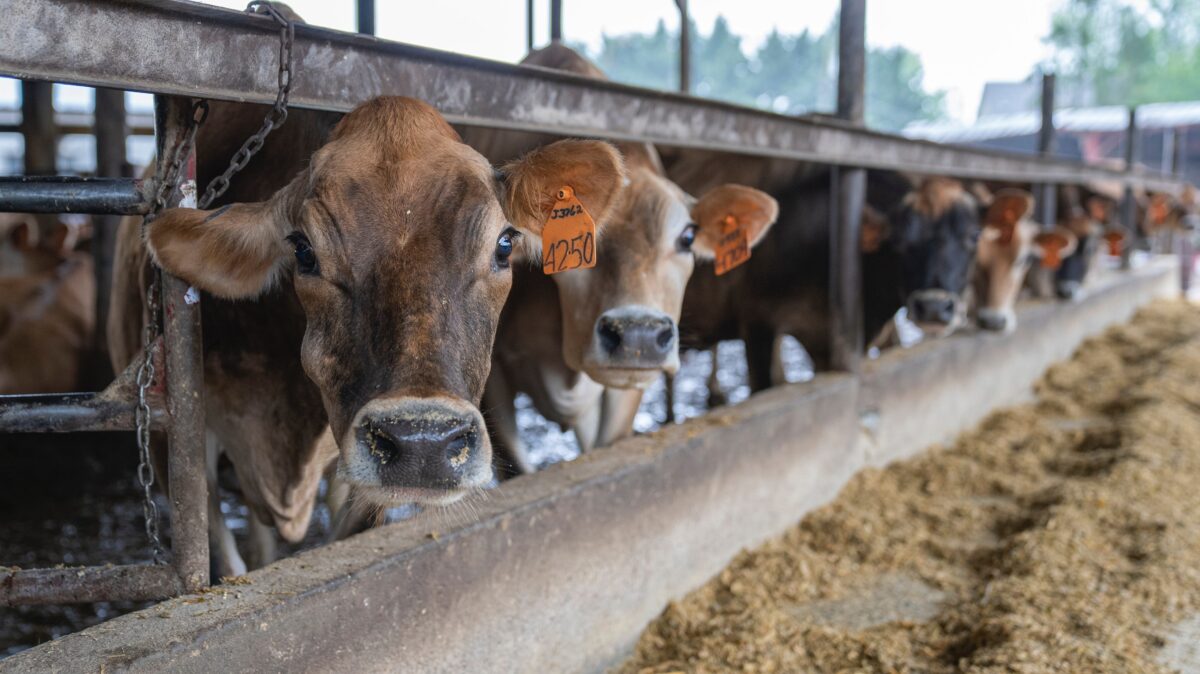
photo credit: Mark Stebnicki, North Carolina Farm Bureau
John Newton, Ph.D.
Former AFBF Economist
As global milk supplies tightened toward the end of 2019, milk prices reached their highest level since 2014, coming in at more than $20 per hundredweight. USDA’s December World Agricultural Supply and Demand Estimates projected that all-milk prices in 2020 would average $19.40 per hundredweight, making 2020 the year that milk prices finally turned the corner.
In mid-January, two things happened: the U.S. and China agreed on a historical Phase 1 trade agreement whereby China made commitments to purchase $40 billion in U.S. agricultural products, and China confirmed the first case of the coronavirus. The markets mostly shrugged off the risk related to the coronavirus, and instead focused on evidence that the Phase 1 purchases would soon begin, which helped to keep milk prices steady for the better part of two months.
Everything changed in mid-March as confirmed cases of COVID-19 in the U.S. quickly led to social distancing and shelter-in-place guidelines. Demand destruction for dairy products accelerated as full- and limited-service restaurant sales declined, schools closed and exports slowed. April’s WASDE report revised the milk price outlook to an annual average price of $14.35 – down more than $5 per hundredweight, or nearly 30%, from December’s forecast. May Class III (milk used to make cheese) and IV (milk used to make nonfat dry milk powder) milk futures, reflecting demand uncertainty expected to occur during the second quarter, have declined by 39% and 42%, respectively, between Jan. 2 and April 23.
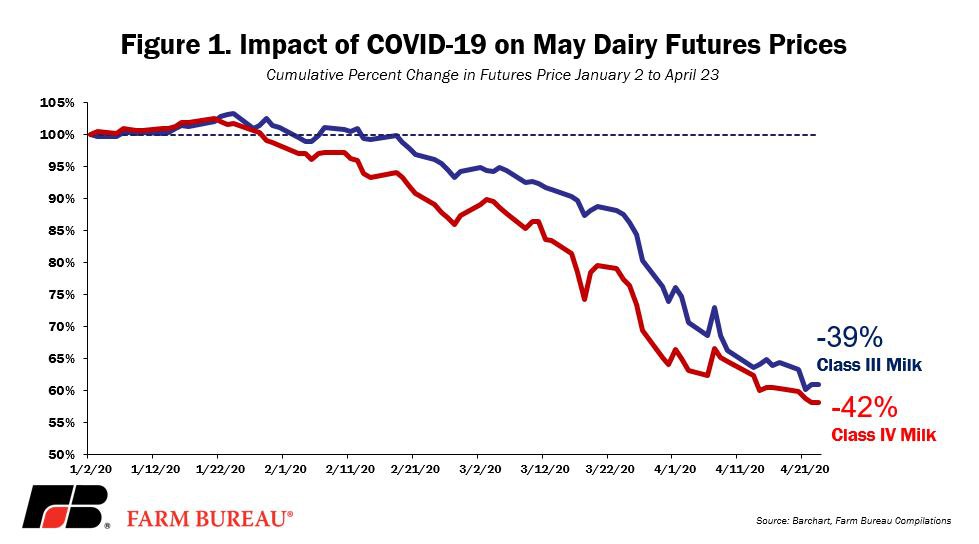
There are a variety of ways dairy farmers can proactively manage their risk. Farmers can use futures and options, USDA’s Dairy Margin Coverage and USDA’s Dairy Revenue Protection.
Dairy Margin Coverage is an insurance-style program, with fixed premiums, offered by USDA’s Farm Service Agency. DMC provides a deficiency payment when the income-over-feed-cost margin falls below a producer-elected support price. Benefits are mostly designed to flow to a dairy farmer’s first 5 million pounds of milk. Current price expectations indicate that a farmer covering 5 million pounds of milk and covering milk at the maximum $9.50 coverage option could receive nearly $100,000 during 2020. The challenge is that very little milk – only 28 billion pounds -- was enrolled in DMC at the maximum protection level. As a result, few producers will actually receive this safety net protection.
Dairy Revenue Protection (Dairy Revenue Protection is Here) is an area-based crop insurance program offered by approved crop insurance providers and administered through USDA’s Risk Management Agency. DRP provides quarterly protection against revenue declines. Protection is available for the five nearby quarters. Unlike DMC, DRP does not cover risk of rising feed costs, and is designed to support dairy farmers when milk prices or cow productivity rapidly and unexpectedly decline. More than 40 billion pounds of milk were insured by DRP for calendar year 2020, and after taking into consideration of the optional protection factor, more than 51 billion pounds of milk have DRP coverage.
A recent study by the University of Minnesota, “Impact of COVID-19 on Dairy Margin Coverage and Dairy Revenue Protection Projected Indemnities in 2020,” estimated that as of April 2, DRP was likely to make nearly double the indemnity payments to dairy farmers than USDA’s DMC program would. DRP was projected to pay more than $900 million to dairy farmers and DMC was expected to make payments totaling nearly $500 million.
Since the study was released in early April, Class III and IV milk prices have declined by 18% and 10%, respectively. As of April 23, DMC is expected to pay $570 million – up nearly $70 million from just two weeks prior. DMC benefits are expected to be the highest in Wisconsin at $135 million followed by Minnesota at $73 million. Farmers in states with larger dairy herds do not benefit as much from DMC due to the 5-million-pound threshold. For example, DMC payments in California are expected to reach $52 million, while Idaho payments will likely total less than $12 million. Figure 2 highlights expected DMC deficiency payments in 2020 as of April 22.
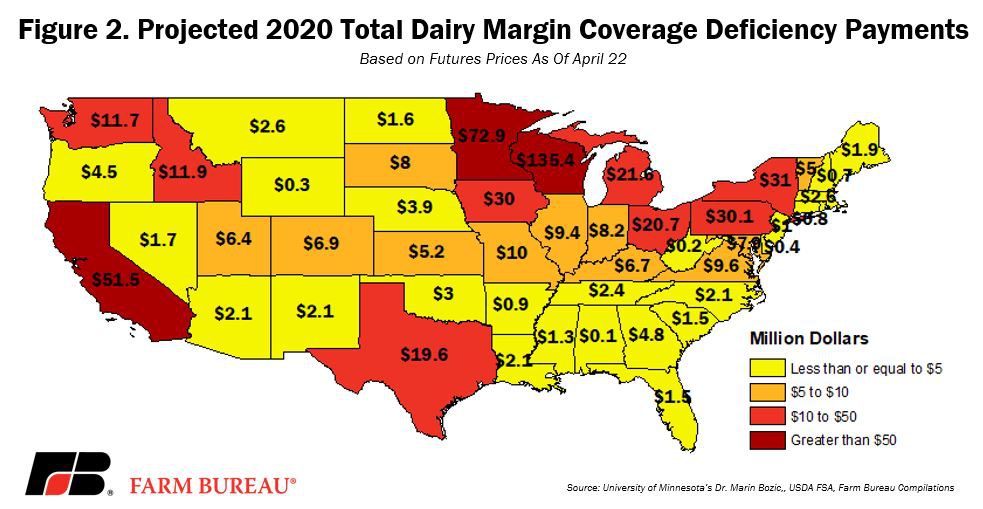
Like DMC, and due to the continued weakness in milk prices, DRP is expected to make indemnities totaling nearly $1.3 billion, up nearly $400 million from early April. A majority of the indemnities, nearly $700 million, or 54%, will likely be made in the second quarter of 2020. DRP does not have limitations based on farm size like DMC, and as a result, the program payments are more aligned with the major milksheds in the U.S. California is currently projected to receive $268 million in indemnities, followed by Wisconsin at $178 million, Idaho at $121 million and Texas at $113 million. Figure 3 highlights expected DRP indemnities as of April 22.
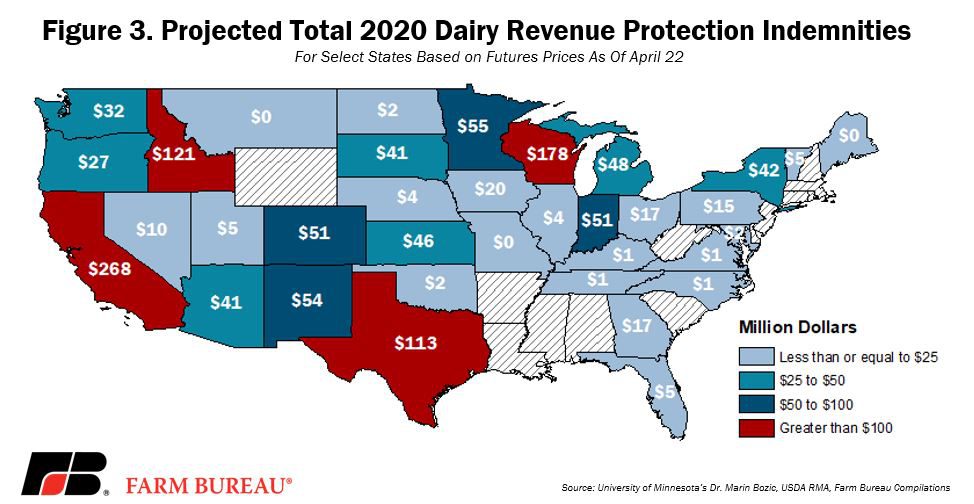
Combined, DRP and DMC are currently expected to make nearly $2 billion in payments to dairy farmers due to COVID-19-related milk price declines. During the second quarter, when the milk prices are expected to be the lowest, DRP and DMC are expected to pay more than $1 billion to dairy farmers, Figure 4. Importantly, if future milk prices improve, the benefits from DRP and DMC would be lower than currently projected.
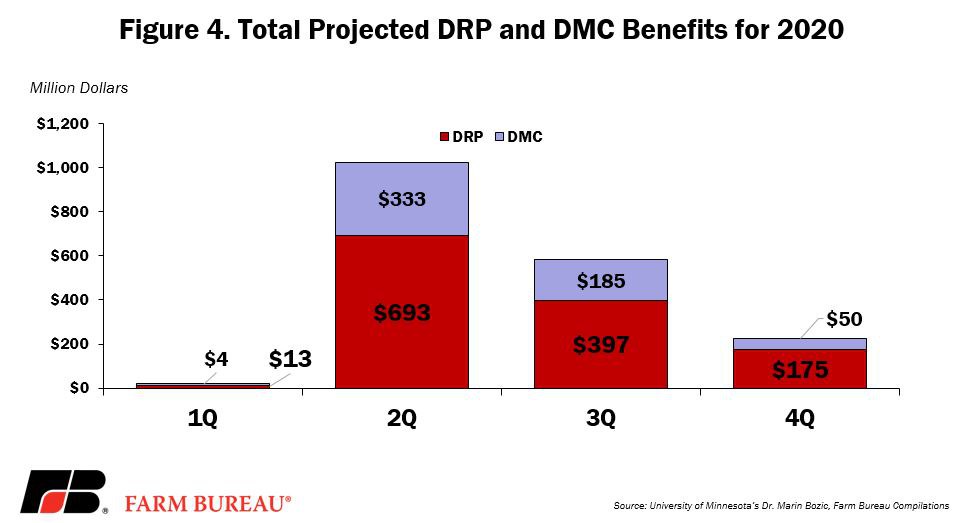
Summary
Milk prices during 2020 have fallen sharply due to COVID-19-related demand destruction. Moreover, with milk being dumped or sold at distressed prices, the re-blending of these losses across cooperative member producers or de-pooling of milk by independent processors is likely to result in farm-level milk prices that have declined by far more than what’s occurred in the futures markets.
DRP and DMC are expected to provide financial support to help offset these losses, but not all producers enrolled in these programs. Less than 30 billion pounds of milk are enrolled in DMC at the highest level of support, and more than 51 billion pounds of milk are covered under DRP. Less than half the milk supply in the U.S. is covered by DRP or DMC – highlighting the need for additional support.
Recognizing this need, the administration and lawmakers have crafted a $16-billion assistance package to help livestock, dairy and specialty crop producers impacted by COVID-19 (UPDATE: What’s in USDA’s New Coronavirus Food Assistance Program?). Combined, the complementary support provided by the Coronavirus Food Assistance Package, DMC and DRP will help dairy farm families. However, producers who took the extra steps to proactively manage their risk – even when the market pointed toward higher milk prices and margins -- are more likely to endure the COVID-19-related price declines than those who did not, further emphasizing the importance of using risk management tools in the dairy industry.
Trending Topics
VIEW ALL